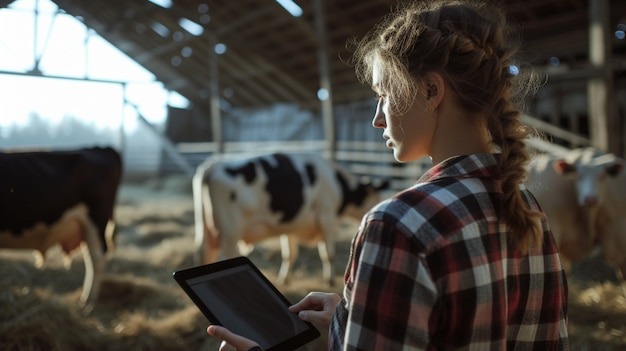In recent years, the agricultural sector has seen a rapid transformation driven by technological advancements. One of the most impactful developments has been the integration of Artificial Intelligence livestock monitoring in agriculture. This technology is revolutionizing how farmers manage and care for their animals, increasing productivity, improving animal health, and promoting sustainable farming practices.
What is AI Livestock Monitoring?
AI livestock monitoring refers to the use of AI technologies, such as machine learning (ML), computer vision, and sensor networks, to track, analyze, and optimize the health, behavior, and productivity of farm animals. By collecting data from various sources, such as wearables, cameras, and environmental sensors, AI can provide farmers with real-time insights into the well-being of their livestock.
These AI systems are designed to detect patterns and anomalies in the behavior of animals, providing farmers with crucial information that helps in making more informed decisions. AI-powered livestock monitoring can significantly enhance productivity, reduce costs, and improve the overall efficiency of farm operations.
Key Benefits of AI in Livestock Monitoring
1. Improved Animal Health
AI technologies can detect early signs of illness or distress in livestock, sometimes before symptoms are visible to the human eye. Using sensors and cameras, AI systems can monitor animals’ body temperature, heart rate, movement patterns, and other indicators of health. Early detection of diseases such as mastitis in dairy cows or lameness in cattle can lead to timely interventions, reducing the need for antibiotics and minimizing the spread of disease.
2. Enhanced Productivity
AI-driven systems can monitor key metrics related to animal growth, reproduction, and milk production. By tracking these metrics, AI can identify animals that are underperforming or not meeting production targets. Farmers can then take action, whether it’s adjusting feeding plans, improving breeding strategies, or providing additional care to animals showing signs of stress or malnutrition.
In dairy farming, AI can optimize milking processes by identifying cows with higher milk yield potential and ensuring efficient milking schedules. AI can also monitor weight gain and feed conversion ratios, helping farmers optimize feed consumption and reduce waste.
3. Reduced Labor Costs
Traditional livestock monitoring requires significant human labor to inspect animals, check their health, and track their behavior. AI automates many of these tasks, reducing the need for frequent manual checks. This allows farmers to allocate their time and resources more efficiently. In remote or large-scale operations, AI-powered drones, cameras, and sensors can cover vast areas, ensuring that livestock are continually monitored without requiring constant human presence.
4. Better Animal Welfare
By continuously monitoring animals’ behavior, AI can help identify signs of distress or discomfort, such as changes in movement patterns or feeding behavior. This can be particularly valuable in detecting conditions like heat stress or injury. Early intervention can reduce animal suffering and improve overall welfare, promoting ethical farming practices.
5. Data-Driven Decision Making
AI gathers vast amounts of data from various sources, including wearables, environmental sensors, and cameras. By processing this data, AI can provide valuable insights into how different factors—such as temperature, feed quality, or space—affect the health and productivity of livestock. This data-driven approach enables farmers to make more accurate, evidence-based decisions that improve the efficiency and sustainability of their operations.
How AI is Used in Livestock Monitoring
1. Wearable Sensors
Wearable sensors, such as RFID tags, collars, or ear tags, are placed on animals to collect data on their movements, feeding patterns, and health. These sensors can detect changes in temperature, heart rate, and activity levels, providing real-time data that can be analyzed by AI algorithms. For example, in dairy cows, wearables can track rumination patterns, which are a good indicator of health and stress levels.
2. Cameras and Computer Vision
AI-powered cameras and computer vision software can be used to monitor livestock in real-time. These systems can analyze images and videos to detect abnormalities in behavior, posture, and movement. For example, AI can identify cows that are not standing or moving normally, which may indicate illness or injury.
Computer vision can also be used in breeding programs to assess the physical characteristics of animals, enabling farmers to make better breeding decisions based on genetic traits, size, and conformation.
3. Environmental Monitoring
AI systems can also integrate data from environmental sensors that monitor factors such as temperature, humidity, and air quality in livestock housing. By analyzing this environmental data, AI can provide insights into how these conditions impact animal health and productivity. For example, in poultry farming, AI can optimize the temperature and humidity levels in poultry houses to ensure optimal conditions for growth and comfort.
4. Automated Feeding and Milking Systems
Automated feeding systems powered by AI can deliver the right amount of feed to livestock at the right time, based on their specific needs and growth stages. Similarly, AI-driven milking machines can detect the optimal time to milk cows, ensuring that the process is both efficient and stress-free for the animals.
